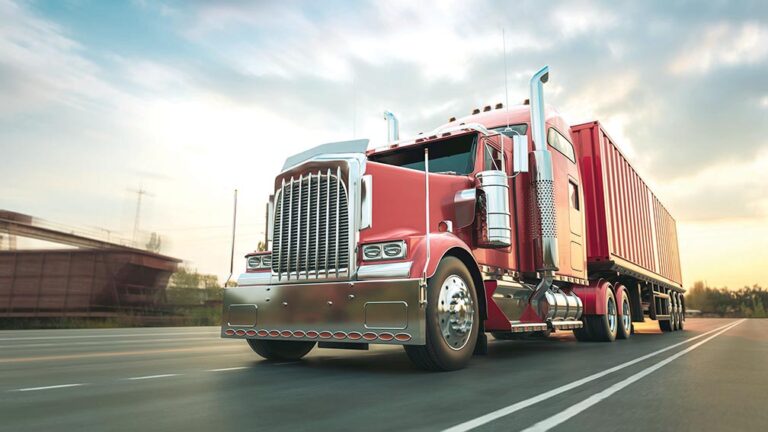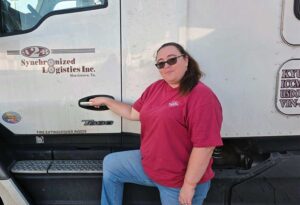Truck drivers who are looking for more local and regional work than their current carrier provides often turn to the intermodal segment of trucking for answers. Many times drivers who are trying out their skills as owner-operators also find a home in intermodal.
But what is intermodal trucking, and what are some of the advantages and disadvantages of driving intermodal?
As the name implies, “intermodal” means that freight-filled containers can be transported by multiple modes of transportation. Containers often arrive in the U.S. by ship, where they can be unloaded and placed on rail cars for movement across the country. Once they are delivered to a rail facility, they are placed on chassis and transported by truck to their final destination. Some containers are trucked directly from the seaport, too.
Since non-trucking modes of transport are often used for longer distances, trucks usually handle the pickup and delivery functions. Some of these are local in nature, with drivers moving several containers in a day’s work. Other moves are more regional, with most containers going to receivers that are within a day’s drive of the port. Depending on the carrier and the availability of work, intermodal drivers often get home multiple times during the week, sometimes daily.
For owner-operators, the equipment requirements for intermodal work can be a little easier to meet than for other segments of the industry. For example, trucks used for intermodal are often older than their over-the-road counterparts. On the West Coast, particularly in California, however, strict emissions-reduction laws have been implemented, all but forcing older equipment out of the business.
Another advantage of intermodal is that many loads are “drop-and-hook” on at least one end of the trip. Since the owners of the chassis generally charge carriers by the day for using them, trailer pools aren’t maintained at most customer locations, so live loading and unloading is common.
At the railyard or port, however, a chassis with attached container is often dropped in a specific area or in a numbered space so it can be easily found. When picking up, drivers often find that these containers have been offloaded and placed on a chassis — ready to hook up and go. All the driver needs is a space number.
Unfortunately, it isn’t always that easy.
Sometimes drivers hook up to an empty chassis and then drive to a designated area where a crane or large forklift loads a container onto the chassis. Or, a driver with a loaded container may drive to an area where the box can be removed and either stacked for later use or immediately loaded onto a ship or rail car. The act of moving the container only takes a few moments, but wait times are often long when personnel can’t locate a container or the container has to be loaded on train or ship in a certain order.
Ports and rail yards can be 24/7 operations or can have specific, sometimes limited, hours. Some truckers wait for hours to get into the facility. Some facilities are run very efficiently and keep wait time as short as possible; others, not so much.
Maintenance of chassis can be a problem, too. Chassis are often owned by the shipping line and rented to the carriers who pull them. Carriers are often reluctant to repair a chassis they don’t own, especially when reimbursement from the chassis owner takes a long time — or doesn’t happen at all.
Ports and rail yards often deal with maintenance by inspecting trucks that are on their way out of the facility. There is often a long line for inspection and another wait if repairs are need, so some drivers would rather take their chances if they haven’t seen a visible problem with the chassis.
When drivers have to hook up to a chassis first, they may have difficulty finding one in good repair. Drivers often would rather deliver the chassis to the facility with a flat tire or a mechanical issue than take the time to get it fixed on the road, especially if the distance isn’t very far.
Drivers can also be unkind to one another when it comes to chassis. It’s not uncommon to find a chassis that’s missing lights, lug nuts or any other item a driver might have needed to make another chassis roadworthy.
Other disadvantages of intermodal trucking include lower compensation than longer-distance forms of trucking. Since the U.S. imports much more than it exports, it can be difficult to find a load returning to the port for shipment, and deadheading is often a possibility.
Additionally, since chassis are usually owned by shipping lines, they can’t be used to haul containers belonging to another shipping line unless the two companies have a cooperation agreement. For example, a driver may return a chassis owned by Maersk to the port and need to pick up a different chassis to haul the next container that’s owned by another company. Even when owned by the same company, containers can be different sizes. For example, a 40-foot container won’t fit on a chassis made for a 20-foot container.
Another drawback to intermodal is that drivers often don’t know anything about the cargo, its weight or how it was loaded. Paperwork, such as bills of lading, are often created in another country, where people speak a different language and use different measurement methods — all of which may not translate perfectly. Often, cargo information such as weights is more of an estimation than reality. Containers are sealed, so drivers usually can’t get a look at how cargo is loaded, making it difficult to predict if the load is top-heavy or leans to one side.
Intermodal trucking can be rewarding, providing steady income and home time for many drivers, but there are also unique challenges.
Drivers who are considering taking on the job would be wise to ask plenty of questions about potential miles and income. Speaking with experienced drivers is a must, since they can provide accurate information about carriers, customers and port and rail facilities. It isn’t uncommon for a driver to have worked for several carriers in the area, and he or she should be able to provide information about each.
Cliff Abbott is an experienced commercial vehicle driver and owner-operator who still holds a CDL in his home state of Alabama. In nearly 40 years in trucking, he’s been an instructor and trainer and has managed safety and recruiting operations for several carriers. Having never lost his love of the road, Cliff has written a book and hundreds of songs and has been writing for The Trucker for more than a decade.
















Syracuse NY rail is mostly bided it to Schneider job hunt ups and they are careless rude